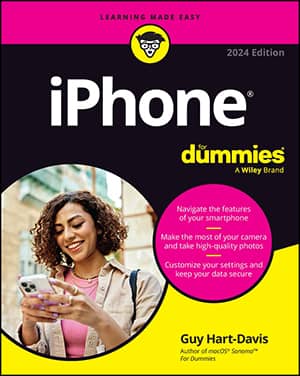Apple’s iCloud service is more than just a wireless hard drive in the sky. iCloud is a complete data synchronization and wireless storage solution. In a nutshell, iCloud stores and manages your digital stuff — your music, photos, contacts, events, and more — and makes it available to all your computers and iDevices automatically.
iCloud pushes information such as email, calendars, contacts, reminders, and bookmarks to and from your computer and to and from your iPhone and other iDevices, and then keeps those items updated on all devices wirelessly and without any effort on your part. iCloud also includes nonsynchronizing options, such as Photo Stream and email.
Your free iCloud account includes 5GB of storage, which is all many users will need. If you have several devices (including Macs and PCs) or like saving data in the cloud, you’ll probably find yourself needing more storage; 20- and 200-gigabyte upgrades are available for $1 and $4 a month, respectively.
A nice touch is that music, apps, periodicals, movies, and TV shows purchased from the iTunes Store, as well as your photo stream and iTunes Match content, don’t count against your 5GB of free storage. iBooks don’t count against your 5GB either, but audiobooks do.
You’ll find that the things that do count — such as mail, documents, photos taken with your iPhone camera, account information, settings, and other app data — don’t use much space, so 5GB may last a long time.
Sync iPhone photos with a computer every so often and then delete the photos from the iPhone. Otherwise, those photos will, over time, start taking up a lot of space.
If you plan to go PC-free but still want to have your email, calendars, contacts, and bookmarks synchronized automatically and wirelessly between computers and other iDevices, here’s how to enable iCloud syncing on your iPhone:
On your Home screen, tap Settings.
In the list of settings on the left, tap iCloud.
Tap Account, and then provide your Apple ID and password (if you haven’t provided it previously).
Tap Done.
A list of apps appears. Tap any individual on/off switch to enable or disable iCloud sync for Mail, Contacts, Calendars, Reminders, Safari (Bookmarks), Notes, and PassBook.
In the same list are five items that don’t have switches:
Photos: Enable or disable three iCloud services with the by now familiar on/off switches:
iCloud Photo Library: Automatically upload and store your entire photo library in iCloud. (This option in new in iOS 8.) The benefit is that you can access all your photos and videos on all your Macs and iDevices. One possible downside: This option could put you over iCloud’s free 5GB limit.
My Photo Stream: Automatically upload photos you shoot with your iPhone camera and send them to all your devices when connected to Wi-Fi.
iCloud Photo Sharing: Create and share albums with other iCloud users, or subscribe to other iCloud users’ shared albums.
iCloud Drive: This new iOS 8 feature lets iCloud-savvy apps open and save documents and data in iCloud:
iCloud Drive: Allow apps to use iCloud Drive.
Look Me Up By Email: Tap to see a list of apps that allow other people to look you up by your Apple ID. When enabled, users of the app will be able to look for you by your first and last names.
Use Cellular Data: Use cellular data for sending and receiving data from your iCloud Drive. Consider enabling this option only if you are fortunate enough to have an unlimited data plan.
Backup: Enable or disable iCloud backup, which backs up your photo library, accounts, documents, and settings whenever your iPhone is plugged in, locked, and connected to Wi-Fi. Tap the Back Up Now button to initiate a backup, well, now.
Keychain: Keep passwords and credit card information you save up to date on all devices you approve. The info is encrypted and can’t be read by Apple.
Find My iPhone: Tap this option to reveal two choices. The first is Find My iPhone, so you can locate, lock, or erase your iPhone and prevent anyone else from erasing or reactivating it without your password. The second option, Send Last Location, tells the iPhone to send its location when the battery gets critically low.
Tap Storage, near the top of the screen, to manage your iCloud storage or upgrade your storage plan.

